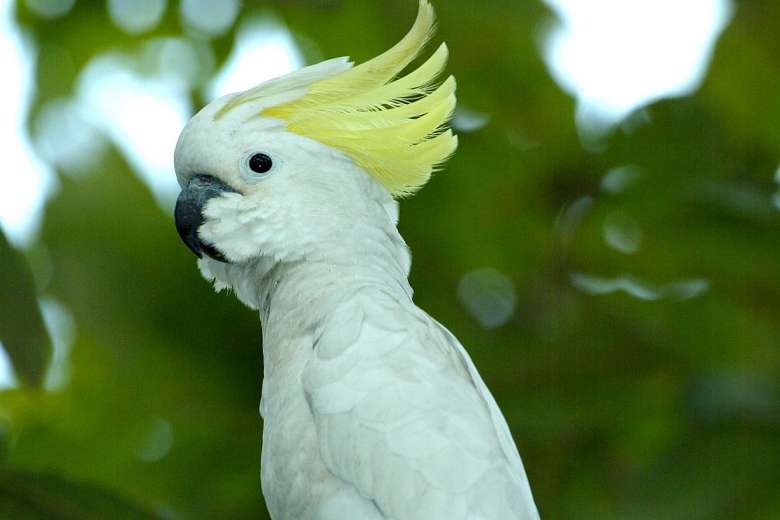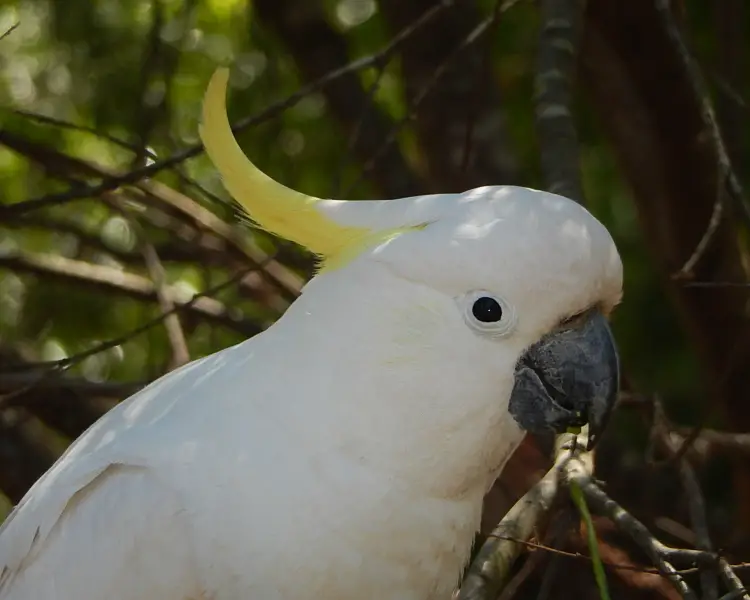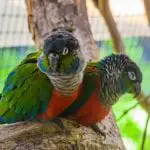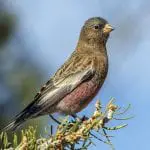Scientific Facts
| Common Name: | Yellow-crested Cockatoo, Lesser sulfur-crested cockatoo, Timor cockatoo, Dwarf sulfur-crested cockatoo |
| Scientific Name: | Cacatua sulphurea |
| Life Span: | Up to 80 years |
| Weight: | 250 to 400 grams |
| Length: | 12.8 to 14 inches |
| Habitat: | Cultivated land and wooded areas |
| Country of Origin: | Sulawesi Island of Indonesia, East Timor, and the Sunda Islands |
Physical Description

The yellow-crested cockatoo is considered to be a bird of medium size, and they share similar physical appearances with other cockatoo breeds. The adults reach a length of 34 centimeters or 13 inches, and the males and females of the species are almost identical. Their visible traits are their bulging forehead, stubby beak, distinct eyes, and their iconic crest. These yellow-crested cockatoos also have a strong wingspan, so these birds must have ample space for flying.
In terms of color, the yellow-crested cockatoo does not come with a lot. Its body is covered elegantly with white feathers, accompanied by slight yellowish tinges on the tips and underneath the tails. Their crest is bright yellow and very prominent. The yellow-crusted cockatoo also has two pale yellow circles on their cheeks. This simple look of the yellow-crusted cockatoo is pronounced with the gray feet and beak. Although it lacks diversity in colors, this cockatoo is still a very pretty and charming bird.
Subspecies

The yellow-crested cockatoo has several subspecies, which are:
- Cacatua sulphurea abbotti or the Abbott’s lesser sulfur-crested cockatoo
- Cacatua sulphurea citrinocristata or the citron-crested cockatoo
- Cacatua sulphurea djampeana
- Cacatua sulphurea occidentalis
- Cacatua sulphurea parvula or the Timor sulfur-crested cockatoo
- Cacatua sulphurea paulandrewi
- Cacatua sulphurea sulphurea
Conservation Status

The yellow-crested cockatoos are declared to be critically endangered. Their numbers have dramatically declined because of illegal trapping for the cage bird trade. Between 1980 and 1992, over 100,000 of these birds were legally exported from Indonesia. The current population is estimated at fewer than 7,000 individuals and is believed to be declining in their numbers.
Availability and Natural Habitat
Like other related cockatoo breeds, the yellow-crested cockatoo is originally found on Sulawesi and the Lesser Sunda Islands. These islands are part of Indonesia and East Timor and serve as a home to many exotic parrots. Because of extensive illegal trapping, the yellow-crested cockatoos have been declared critically endangered. Also, there is a population of these birds existing in Hong Kong. This small population started from a number of yellow-crested cockatoos in captivity that were released in 1941.
Behavior, Exercise, and Training
If you are after quiet and well-behaved pets, yellow-crested cockatoos might not be up your alley. These birds can be very, very loud. Even if they might not be the best talkers, they have the ability to repeat a few words coherently. But, most of the time, their loud noise only comes from their mimicking attempts in human conversations and basic human speech. Usually, they just sound quite noisy, repetitive, and a mix of screams, yells, and mumbled words. With just a little patience, these outbursts of noise can be something to get used to. But, you have to consider how neighbors will be accepting of this.
Yellow-crested cockatoos also have several traits that make them well-loved all over the world. They are always game for goofing off and having fun. Aside from this attitude, these birds can also be cuddly and affectionate. For keeping these birds entertained, it is important to provide them will a good amount of toys, but aside from this, you must not forget that nothing can beat actual social interaction.
All animals need exercise, and that includes yellow-crested cockatoos. Owners need to provide these birds with a minimum of 3 to 4 hours outside of the cage per day so that the bird can play and stretch their muscles. This time spent out of the cage also provides them with the essential human contact that the birds need. Cockatoos have strong beaks and jaws, so it is important to provide them with plenty of chew toys for this need.
Food and Eating Habits
In the wild, these yellow-crusted cockatoos thrive on a variety of insects, flower buds, seeds, and fruits. A seed-based mix for cockatoos will be a great choice for your pet’s diet. But it will not be enough. Supplementation using vitamins and minerals is still needed, and keepers can also opt for feeding the birds with fruits and vegetables to get the vitamins from there instead. Keepers can go for apples, carrots, cabbage, and oranges.
Breeding
Because the yellow-crested cockatoos are threatened with extinction, successful breeding by many organizations and private keepers allow the preservation of the species. There are currently no breeding regulations in Canada, the United Kingdom, and the United States, but other countries may have, so it would still be best to consult local authorities before attempting to do so.
The ideal environment for breeding yellow-crested cockatoos is accomplished in an aviary. Place the yellow-crested cockatoo’s square nesting box, or a circular hollowed-out tree trunk of the same approximate size, high in the aviary. On the bottom of the nest box, put a 10 cm or 4 inches layer of soft bedding.
The nesting box for a small cockatoo should be 25 centimeters to 30 centimeters or 10 inches to 12 inches in width and 23 inches to 31 inches or 60 cm to 80 cm in height, with a hole size of 10 to 12 cm. For a medium cockatoo, it should be 12 inches to 14 inches or 30 to 35 cm wide and 31 inches to 39 inches in height, with a hole size of 4 to 5 inches.
After breeding, The female yellow-crusted cockatoo will lay 2 to 3 eggs in a single clutch. Brooding for ideal situations usually lasts between 25 to 30 days. The baby yellow-crested cockatoos are naked and blind when they hatch, and their eyes stay closed for several weeks more. These juveniles take between 60 and 100 days to become fully plumed. During this moment, these young birds will begin to explore outside of the nest. However, they will still be dependent on their parents for a couple of weeks before readily leave the nest for good.
Common Health Problems
Yellow-crested cockatoos are hardy, and they do not easily acquire diseases. Though it can be difficult to determine their illnesses, there are visible signs that owners can look out for. Most of the time, these can be seen from bare spots, ruffles, and lack of luster in their plumage. Other times, sickness can be exhibited by discharge from their nostrils, having no appetite, having slitted eyes, neurotic screaming, feather plucking, changes in the feces, and sleeping on both feet at rest instead of tucking one foot up.
Some of the most common illnesses acquired by these birds are psittacosis or parrot fever, feather picking, respiratory diseases, coccidiosis, inflammation in the intestines, and parasites. Once they acquire forms of this illness, isolate them in a hospital cage and place an infrared lamp at about 23 inches distance from the cage. If the bird does not perk up withing 24 hours, keepers must rush to a veterinarian with avian specialization for diagnosis and treatment plans.
Environment and Housing
For their housing, keepers must provide owners with a spacious cage with the measurements of 24 inches by 24 inches by 26 inches, which are favorable for the ease of movement and flight. If it is possible, it is better to arrange an outdoor cage for these birds where they can fly around, as long as it comes with a secure locking system. For their nesting box, it should be measured at 12 inches by 12 inches by 24 inches, at the least.
For yellow-crested cockatoos, the larger the enclosure can be, the better. The ideal size of any bird cage should be at least equal to three flight wingspans of the bird. Anything that would be smaller can be detrimental to the bird unless it has freedom outside the cage.
Horizontal bars in the cage is also important because cockatoos need to climb regularly. Also, they must also keep in mind that because of the strength of their beaks, they can bend bars and pop the joints on their cages.
You should also provide one or two perches about ¾ inches in diameter and dishes hanging from the side for feed, grit, and water. Try to place the perches away from the dishes, so the food and water dishes do not become soiled with bird droppings. Do not use plastic in case the bird chews on it and become hazardous.
Fun Facts about the Yellow-Crested Cockatoo
- The largest recorded decrease of the population of the yellow-crested cockatoo was recorded in 1980, which immediately made the birds an endangered species.
- Baretta, an old famous TV series, featured a yellow-crested cockatoo named Lessor.
- The plumage of the yellow-crested cockatoo is more of a white overall, but their ear coverts, under tail feathers, underwings, and crest, are all colored with a bright yellow.
- The courtship of yellow-crested cockatoos involves mutual preening, erect crests, and head bobbing.
- The clutch size of yellow-crested cockatoos is usually 2 to 3 eggs.
Where Can You Get a Pet Yellow-Crested Cockatoo?
With their beautiful personalities and elegant colors, the yellow-crusted cockatoos are a popular choice for a pet to keep in captivity. But, this is a species not commonly found in pet stores, so acquiring them will require looking for a reputable breeder.
How to Care for a Pet Yellow-Crested Cockatoo?
Before getting a yellow-crested cockatoo, potential keepers should know that these are very sensitive birds that require a huge commitment of time. If you consider getting a cockatoo, make sure that you have enough spare time to spend interacting with it. Like other breeds of cockatoos, these birds are very social in nature, and they require a lot of interaction with humans to remain emotionally healthy. If ignored, the yellow-crested cockatoos may resort to destructive behavior and screaming very quickly.
These birds are not a good choice for those who live in apartment complexes or condominiums. While they are quieter compared to other cockatoos, they can still make a lot of noise, especially when they feel like it.
Aside from this, here are essential care tips all yellow-crested cockatoo owners must keep in mind:
- Before anything else, make sure that you have enough time to spend with your feathery friend. These birds do not receive enough attention, love, and affection will only be depressed, frustrated, noisy, and aggressive.
- If you are interested in training your feathery friend, you need to teach them two essential things: first, to defecate in the right places and to not be aggressive against other family members.
- Make sure that you can provide the bird with the space it needs to explore, climb, and play. It is also important to have multiple locks in the cage so that the birds will not find a way to escape.
- Provide plenty of toys, especially those that are made from wood.
Frequently Asked Questions
How much does a yellow-crested cockatoo cost?
Red-shouldered macaws are available for 500 dollars to 1,000 dollars, more or less.
Why is the yellow-crested cockatoo endangered?
The yellow-crested cockatoo populations have decreased increasingly because of illegal trapping and illegal bird-trade.
How long do yellow-crested cockatoos live?
Yellow-crusted cockatoos live for about 40 years on average, but some have been reported to reach 80 years old.
What does the yellow-crested cockatoo eat?
These birds usually eat seeds, crops, buds, fruits, and berries.
Why does my yellow-crested cockatoo scream at night?
Yellow-crested cockatoos usually scream out of boredom and frustration.



